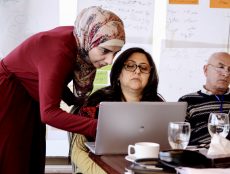
Articles
Editor’s Picks
Education without Brick and Mortar: Stanford Online High School
By Cait Etherington
October 09, 2017
Part 1 of a Three-Part Series on Stanford Online High School
There was once a perception that online high schools can’t replace the “real thing”—namely, a quality face-to-face classroom experience. In 2017, this perception is finally shifting, and Stanford Online High School (Stanford OHS) is one of the online secondary schools driving this change. Thanks to its now established track-record and the currency it naturally has due to its affiliation with Stanford University, Stanford OHS continues to prove that an online high school experience can be even more rigorous and engaging than the type of education students typically receive in face-to-face school environments.
Building a Great School without Brick and Mortar

Current Head of School, Dr. Tomohiro Hoshi, has been with Stanford Online High School since 2008. “When I first arrived, I was a graduate student in philosophy at Stanford and finishing my doctorate. I was asked to develop a curriculum in philosophy, but I was very interested in the idea of the school and later joined as a teacher.” Hoshi, who had previously taught high school in Japan, wasn’t entirely new to secondary level teaching but at the time, he was new to teaching online.
Since Hoshi arrived, only two years into the school’s existence, Stanford OHS has grown significantly. “Between 2010 and 2015, we were growing 10 to 20 percent each year,” he reports. While the school’s numbers have been relatively stable since Hoshi took over as Head of School in 2015 (the school now provides an online secondary education to approximately 750 students each year), he emphasizes that the school continues to grow in other ways. “One of our current goals is to focus more on diversity—in terms of faculty and also in terms of student recruitment. For this reason, we are looking to get more financial support to expand financial aid, but we are also thinking about the different types of support that a more diverse student body might need to be successful in an online high school.”
Hoshi notes that in recent years, the school has also begun to pay more attention to student advising and student wellness initiatives, which include courses on adolescent development. Dr. Tracy Michelle Steele, the Director of Counseling at Stanford OHS, has found, “Sometimes the types of gifted and talented students attracted to our school are intellectually advanced but not necessarily socially or emotionally advanced, so strong advising can be especially important in this type of school.”
Strengths of an Online Secondary Education

Asked to reflect on the strengths not only of Stanford OHS but also online high schools in general, Hoshi emphasizes that there are several features and conditions that set such schools apart. “Certainly, being online we have more opportunity to put the right kinds of people together. We are still officially part of Stanford, but our teachers are living in different areas—mostly in California but about 10% live outside California. Since many of our teachers work remotely, we can bring together the very best teachers–in fact, a majority have PhDs and often from very prestigious universities. We can recruit teachers who are very qualified in their field who have an interest in this educational enterprise. Not having geographic constraints, we can also recruit the best students and the ones who are most likely to do well in this type of school.”
However, as Hoshi observes, Stanford OHS’ strengths stretch beyond its people. “There is a lot of flexibility given to our students—they can design their own programs to some extent.” A key factor is also the school’s approach to course placement: “Our commitment to placing students by ability—their ability to pass a course—is also something that distinguishes our approach. In our school, an eighth grade student can take post-AP mathematics courses if they are prepared.”
Finally, Hoshi has found that there are distinct advantages to bringing together students from around the world. “We offer a course called Democracy, Freedom, and Rule of Law. We have students all over the world and the United States in this course. It is a very global classroom so students must learn how to respect these topics in a global context. Our students are also engaged with each other in an ongoing fashion. This is very different than an exchange program—they may be classmates for years, which opens up new opportunities for growth.”
Future Goals for Stanford Online High School
As Hoshi says, “Ultimately, our school mission is to create a community expert teachers and intellectually passionate and talented students.” All signs suggest that this is precisely what Stanford OHS is currently doing, and this success is no doubt what has secured the school’s reputation as a leader in online secondary education. Moving forward, administrators and faculty at the school look forward to sharing their best practices with a broader audience. “We have over ten years of educational experience in synchronous learning,” explains Hoshi. “We are currently trying to articulate what we’ve learned and put this documentation into practice but also present on our research, so we can continue to be recognized as leaders in the field.”









No Comments